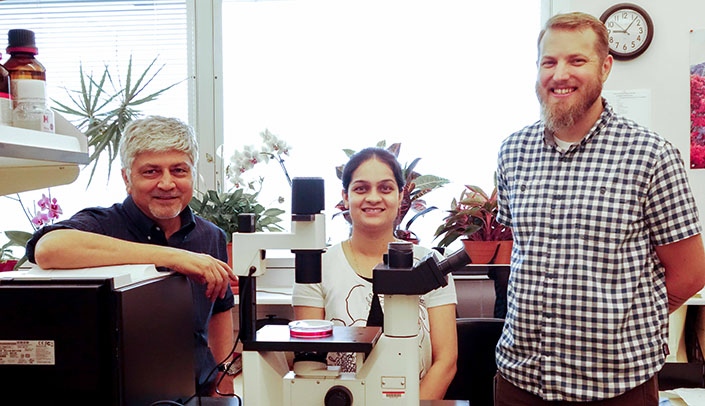The capacity of the human central nervous system to regenerate after injury or illness is limited, and the resulting functional impairments carry a vast societal and personal burden. In glaucoma, degeneration of retinal ganglion cells (RGCs) — the axons of which form the optic nerve connecting the retina to the brain — leads to permanent blindness. There is currently no effective treatment for RGC degeneration.
Now, UNMC researcher Iqbal Ahmad, Ph.D., and colleagues show that human RGCs can be regenerated in an in vitro setting helped by lessons learned in rodent models. The discovery is detailed in the journal Development.
“This finding could lead to new methods of screening for drugs and genes impacted by glaucoma to help treat and possibly reverse vision loss in people suffering from the disease,” said Dr. Ahmad, a professor in the UNMC Department of Ophthalmology and Visual Sciences.
RGCs are key in sending messages to the brain through a series of synapses and connections that tell us what the eye sees. In people who suffer from glaucoma, it’s the degeneration of these cells that lead to loss of sight, Dr. Ahmad said.
Dr. Ahmad and his team of investigators found that when the mTOR signaling pathway, present in all cell types and essential for cell survival, is activated in RGCs the cells begin to regenerate and thrive. The researchers used a microfluidic chamber system to see how axons regenerated after axotomy.
“I greatly owe the success of the project to Dr. Pooja Teotia, a senior member of the lab and an instructor in our department who established the microfluidic model of optic nerve regeneration, and Dr. Matthew Van Hook, an assistant professor in our department, who determined the functional features of the cells,” Dr. Ahmad said.
Dr. Ahmad has spent 25 years studying the stem cell approach to understand and treat glaucoma, which is called a silent robber of vision because it strikes without warning or any noticeable symptoms. Glaucoma is the second leading cause of irreversible blindness and affects more than 3 million people in the United States and 60 million people worldwide.
The significance of this work, Dr. Ahmad said, is that it is done using human adult pluripotent stem cells, whereas previous work was done only in rats and mice. While those animal models provided insight into better understanding the disease progression of glaucoma, research using human RGCs will translate more readily when it comes to potential drug and gene therapies, he said. His lab has already applied for a patent on the technology that shows how RGCs can be regenerated.
“We are hopeful this process will bring us one step closer to recapturing sight in those patients who suffer from vision loss because of glaucoma,” he said.

I have a vested interest in this exciting discovery. Thank you and please keep moving forward to better treatments. Congratulations
Congratulations! Great teamwork!
I have a good friend who suffers from vision loss as a result of glaucoma. This is welcome news.